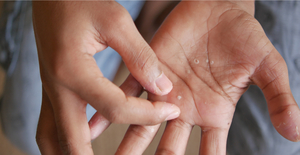Dermatologists near me
in Louisiana
Own a clinic? Add your location.
Help patients book appointments with you on Solv. It's free!
0 instant-book locations
Alison Penton, MD
Alison Penton, MD
- Lafayette Office1245 S College Rd, Lafayette, LA 70503
Katherine Brag, MD
Katherine Brag, MD
Brittany Stumpf, MD
Brittany Stumpf, MD
Elizabeth Grieshaber, MD
Elizabeth Grieshaber, MD
- Nia K Terezakis MD Apmc3800 Houma Blvd, Metairie, LA 70006
Brian Lee, MD
Brian Lee, MD
- Family Dermatology Specialists3421 N Causeway Blvd, Metairie, LA 70002
Zeena Al-Dujaili, MD
Zeena Al-Dujaili, MD
Deirdre Hooper, MD
Deirdre Hooper, MD
Sarah Jackson, MD
Sarah Jackson, MD
Katy Wiltz, MD
Katy Wiltz, MD
Howard Ragland, MD
Howard Ragland, MD
Robert Jones, MD
Robert Jones, MD
Maria Ibanez-Labadie, MD
Maria Ibanez-Labadie, MD
Aimee Coscarart, MD
Aimee Coscarart, MD
Julie Danna, MD
Julie Danna, MD
Suneeta Walia, MD
Suneeta Walia, MD
Aimee Hasney, MD
Aimee Hasney, MD
Marilyn Ray, MD
Marilyn Ray, MD
Jessica Ochsner, MD
Jessica Ochsner, MD
Neil Farnsworth, MD
Neil Farnsworth, MD
Mary Lupo, MD
Mary Lupo, MD
Own a clinic? Add your location.
Help patients book appointments with you on Solv. It's free!
About Dermatologists
A dermatologist is a medical doctor who specializes in diagnosing, treating, and preventing diseases of the skin, hair, and nails. These doctors generally need about 12 years of schooling and education to earn their titles.
A dermatologist can treat more than 3,000 conditions that affect the skin, hair, and nails, reports the AUC. Common dermatological procedures, according to the University of Rochester Medical Center (URMC), include acne scar removal, dermabrasion, and laser surgery for skin conditions such as port-wine stains, warts, and scars.
What is dermatology?
Dermatology is a medical specialty that involves treating and managing skin conditions, according to the National Institutes of Health (NIH). The NIH adds that dermatology is one of the most diverse medical specialties that treats patients from all age groups who may have skin diseases that are inherited, inflammatory, environmental, occupational, and malignant.
Qualifications
People who want to be a dermatologist must earn a bachelor’s degree and complete four years of medical school, reports the AUC. Then, they must complete a one-year internship and a three-year residency in dermatology.
After earning their titles, dermatologists have the option to continue with their education and pursue a subspecialty. According to the AUC, dermatology subspecialties include cosmetic dermatology, dermatopathology, pediatric dermatology, and Mohs surgery.
Common conditions
Dermatologists can treat a wide range of skin conditions and diseases. According to Penn Medicine Dermatology, these conditions include acne, broken blood vessels, blemishes, discoloration, rosacea, and cancer. Fine lines, wrinkles, spider veins, and unwanted hair growth are other common conditions that can be treated by a skin care doctor.
Procedures
Dermatologists are trained to perform a large variety of skin, hair, and nail conditions. A skin doctor may combine procedures to help patients address their skin concerns or medical conditions.
Dermatologic procedures include:
- Chemical peels, which use a chemical solution to improve the appearance and health of skin by removing damaged outer layers, reports URMC.
- Cosmetic injections, which can reduce the appearance of wrinkles and add volume back to the face, reports the University of Utah Health.
- Cryotherapy, which is a type of cold therapy that can destroy skin growths and lesions, reports the University of Utah Health.
- Dermabrasion, which is a skin resurfacing procedure that can remove the top layer of skin to minimize fine lines and scarring, reports URMC.
- Excision of lesions, which involves using a razor, scissors, and other devices to remove unwanted skin lesions, reports the NIH.
- Hair removal or restoration, which involves removing unwanted hair and restoring hair that was lost to balding.
- Laser surgery, which is surgery that can remove skin cancer and skin lesions using a laser, reports URMC.
- Vein procedures, which focus on removing spider veins and varicose veins.
- Tumescent liposuction, which involves injecting a medicated solution into areas with unwanted fat, and removing the fat using a suction device, reports the NIH.
- Skin grafts and flaps, which involves removing skin from a part of the body to repair missing or damaged skin, reports the NIH.
- Biopsies, which are a procedure in which a tissue sample is taken from the body and evaluated for diseases such as cancer.
- PUVA, which is a type of UV radiation therapy used to treat conditions including psoriasis and vitiligo, reports the NIH.
- Mohs surgery, which is a method of removing skin cancer without damaging surrounding healthy skin, reports the NIH.

Updated on Jan 25, 2025
Solv has strict sourcing guidelines and relies on peer-reviewed studies, academic research institutions, and medical associations. We avoid using tertiary references.
Related searches
DOT Exam in Louisiana
Ear Wax Removal in Louisiana
Physical Exam in Louisiana
Sports Physicals in Louisiana
A1C Test in Louisiana
Basic Metabolic Panel in Louisiana
Blood Test in Louisiana
CMP Test in Louisiana
COVID-19 Antibody Test in Louisiana
Cholesterol Test in Louisiana
Diabetes Test in Louisiana
Diagnostic Test in Louisiana
Drug Test in Louisiana
Glucose Test in Louisiana
Hepatitis test in Louisiana
Mono Test in Louisiana
Pulmonary Function Test in Louisiana
RSV Test in Louisiana
Strep Test in Louisiana
TB Test in Louisiana
Urinalysis in Louisiana
Vitamin D Test in Louisiana
Everyday Healthcare, Simplified
Expert advice to help you live your best life



